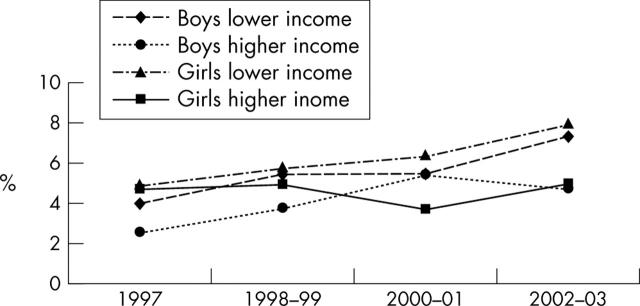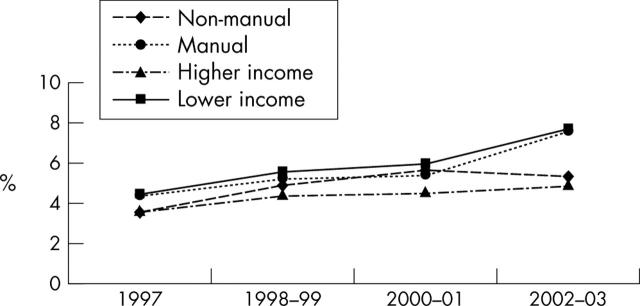Abstract
Aims: To examine the childhood overweight and obesity prevalence trends between 1974 and 2003 and to assess whether these trends relate to parental social class and household income.
Methods: A school based and a general population health survey: the National Study of Health and Growth in 1974, 1984, and 1994, and the Health Survey for England, yearly from 1996 to 2003. Participants were 14 587 white boys and 14 014 white girls aged 5–10 years. Overweight and obesity prevalence were calculated using UK specific as well as international body mass index (kg/m2) cut-offs. Socioeconomic status was measured using the Registrar General's social class; household income (1997 onwards only) was adjusted for household size.
Results: The prevalence of obesity (UK specific definition) in boys increased from 1.2% in 1984 to 3.4% in 1996–97 and 6.0% in 2002–03. In girls, obesity increased from 1.8% in 1984 to 4.5% in 1996–97 and 6.6% in 2002–03. Obesity prevalence has been increasing at accelerating rates in the more recent years. Children from manual social classes had marginally higher odds (OR 1.14, 95% CI 0.98 to 1.33) and children from higher income households had lower odds (OR 0.74, 95% CI 0.61 to 0.89) to be obese than their peers from non-manual class, and lower income households, respectively.
Conclusion: Childhood obesity is increasing rapidly into the 2000s in England and these increases are more marked among children from lower socioeconomic strata. There is an urgent need for action to prevent further increase in obesity among children.
Full Text
The Full Text of this article is available as a PDF (82.9 KB).
Figure 1.
Obesity prevalence trends from 1997 to 2002–03 by income category and sex. Lower income: bottom 50% of income distribution of each individual year; higher income: top 50% of income distribution of each individual year.
Figure 2.
Obesity prevalence trends from 1997 to 2002–03 by income group and social class for boys and girls combined. Lower income: bottom 50% of income distribution of each individual year; higher income: top 50% of income distribution of each individual year.
Selected References
These references are in PubMed. This may not be the complete list of references from this article.
- Ball K., Mishra G., Crawford D. Which aspects of socioeconomic status are related to obesity among men and women? Int J Obes Relat Metab Disord. 2002 Apr;26(4):559–565. doi: 10.1038/sj.ijo.0801960. [DOI] [PubMed] [Google Scholar]
- Cameron N. The growth of London schoolchildren 1904-1966: an analysis of secular trend and intra-county variation. Ann Hum Biol. 1979 Nov-Dec;6(6):505–525. doi: 10.1080/03014467900003921. [DOI] [PubMed] [Google Scholar]
- Chandola T. Social class differences in mortality using the new UK National Statistics Socio-Economic Classification. Soc Sci Med. 2000 Mar;50(5):641–649. doi: 10.1016/s0277-9536(99)00310-x. [DOI] [PubMed] [Google Scholar]
- Chinn S., Rona R. J. International definitions of overweight and obesity for children: a lasting solution? Ann Hum Biol. 2002 May-Jun;29(3):306–313. doi: 10.1080/03014460110085340. [DOI] [PubMed] [Google Scholar]
- Chinn S., Rona R. J. Prevalence and trends in overweight and obesity in three cross sectional studies of British Children, 1974-94. BMJ. 2001 Jan 6;322(7277):24–26. doi: 10.1136/bmj.322.7277.24. [DOI] [PMC free article] [PubMed] [Google Scholar]
- Chinn S., Rona R. J. Re: international definitions of overweight and obesity for children: a lasting solution? Ann Hum Biol. 2004 Nov-Dec;31(6):695–696. doi: 10.1080/13682820400010558. [DOI] [PubMed] [Google Scholar]
- Chinn S., Rona R. J. Trends in weight-for-height and triceps skinfold thickness for English and Scottish children, 1972-1982 and 1982-1990. Paediatr Perinat Epidemiol. 1994 Jan;8(1):90–106. doi: 10.1111/j.1365-3016.1994.tb00438.x. [DOI] [PubMed] [Google Scholar]
- Cole T. J., Freeman J. V., Preece M. A. British 1990 growth reference centiles for weight, height, body mass index and head circumference fitted by maximum penalized likelihood. Stat Med. 1998 Feb 28;17(4):407–429. [PubMed] [Google Scholar]
- Delamothe T., Smith R. PubMed Central: creating an Aladdin's cave of ideas. BMJ. 2001 Jan 6;322(7277):1–2. doi: 10.1136/bmj.322.7277.1. [DOI] [PMC free article] [PubMed] [Google Scholar]
- Drewnowski Adam, Specter S. E. Poverty and obesity: the role of energy density and energy costs. Am J Clin Nutr. 2004 Jan;79(1):6–16. doi: 10.1093/ajcn/79.1.6. [DOI] [PubMed] [Google Scholar]
- Duran-Tauleria E., Rona R. J., Chinn S. Factors associated with weight for height and skinfold thickness in British children. J Epidemiol Community Health. 1995 Oct;49(5):466–473. doi: 10.1136/jech.49.5.466. [DOI] [PMC free article] [PubMed] [Google Scholar]
- Engeland Anders, Bjørge Tone, Søgaard Anne Johanne, Tverdal Aage. Body mass index in adolescence in relation to total mortality: 32-year follow-up of 227,000 Norwegian boys and girls. Am J Epidemiol. 2003 Mar 15;157(6):517–523. doi: 10.1093/aje/kwf219. [DOI] [PubMed] [Google Scholar]
- Fagot-Campagna A., Pettitt D. J., Engelgau M. M., Burrows N. R., Geiss L. S., Valdez R., Beckles G. L., Saaddine J., Gregg E. W., Williamson D. F. Type 2 diabetes among North American children and adolescents: an epidemiologic review and a public health perspective. J Pediatr. 2000 May;136(5):664–672. doi: 10.1067/mpd.2000.105141. [DOI] [PubMed] [Google Scholar]
- Gunnell D. J., Frankel S. J., Nanchahal K., Peters T. J., Davey Smith G. Childhood obesity and adult cardiovascular mortality: a 57-y follow-up study based on the Boyd Orr cohort. Am J Clin Nutr. 1998 Jun;67(6):1111–1118. doi: 10.1093/ajcn/67.6.1111. [DOI] [PubMed] [Google Scholar]
- Guo S. S., Chumlea W. C. Tracking of body mass index in children in relation to overweight in adulthood. Am J Clin Nutr. 1999 Jul;70(1):145S–148S. doi: 10.1093/ajcn/70.1.145s. [DOI] [PubMed] [Google Scholar]
- Haines A., Heath I., Smith R. Joining together to combat poverty. Everybody welcome and needed. BMJ. 2000 Jan 1;320(7226):1–2. doi: 10.1136/bmj.320.7226.1. [DOI] [PMC free article] [PubMed] [Google Scholar]
- Hughes J. M., Li L., Chinn S., Rona R. J. Trends in growth in England and Scotland, 1972 to 1994. Arch Dis Child. 1997 Mar;76(3):182–189. doi: 10.1136/adc.76.3.182. [DOI] [PMC free article] [PubMed] [Google Scholar]
- Jebb Susan A., Rennie Kirsten L., Cole Tim J. Prevalence of overweight and obesity among young people in Great Britain. Public Health Nutr. 2004 May;7(3):461–465. doi: 10.1079/PHN2003539. [DOI] [PubMed] [Google Scholar]
- Joung I. M., van der Meer J. B., Mackenbach J. P. Marital status and health care utilization. Int J Epidemiol. 1995 Jun;24(3):569–575. doi: 10.1093/ije/24.3.569. [DOI] [PubMed] [Google Scholar]
- Kinra S., Nelder R. P., Lewendon G. J. Deprivation and childhood obesity: a cross sectional study of 20,973 children in Plymouth, United Kingdom. J Epidemiol Community Health. 2000 Jun;54(6):456–460. doi: 10.1136/jech.54.6.456. [DOI] [PMC free article] [PubMed] [Google Scholar]
- Kvaavik Elisabeth, Tell Grethe S., Klepp Knut-Inge. Predictors and tracking of body mass index from adolescence into adulthood: follow-up of 18 to 20 years in the Oslo Youth Study. Arch Pediatr Adolesc Med. 2003 Dec;157(12):1212–1218. doi: 10.1001/archpedi.157.12.1212. [DOI] [PubMed] [Google Scholar]
- Laitinen J., Power C., Järvelin M. R. Family social class, maternal body mass index, childhood body mass index, and age at menarche as predictors of adult obesity. Am J Clin Nutr. 2001 Sep;74(3):287–294. doi: 10.1093/ajcn/74.3.287. [DOI] [PubMed] [Google Scholar]
- Langenberg C., Hardy R., Kuh D., Brunner E., Wadsworth M. Central and total obesity in middle aged men and women in relation to lifetime socioeconomic status: evidence from a national birth cohort. J Epidemiol Community Health. 2003 Oct;57(10):816–822. doi: 10.1136/jech.57.10.816. [DOI] [PMC free article] [PubMed] [Google Scholar]
- Lobstein T. J., James W. P. T., Cole T. J. Increasing levels of excess weight among children in England. Int J Obes Relat Metab Disord. 2003 Sep;27(9):1136–1138. doi: 10.1038/sj.ijo.0802324. [DOI] [PubMed] [Google Scholar]
- Lu Ning, Samuels Michael E., Huang Kuo-Cherh. Dietary behavior in relation to socioeconomic characteristics and self-perceived health status. J Health Care Poor Underserved. 2002 May;13(2):241–257. doi: 10.1353/hpu.2010.0567. [DOI] [PubMed] [Google Scholar]
- Molarius Anu. The contribution of lifestyle factors to socioeconomic differences in obesity in men and women--a population-based study in Sweden. Eur J Epidemiol. 2003;18(3):227–234. doi: 10.1023/A:1023376012627. [DOI] [PubMed] [Google Scholar]
- Must A., Jacques P. F., Dallal G. E., Bajema C. J., Dietz W. H. Long-term morbidity and mortality of overweight adolescents. A follow-up of the Harvard Growth Study of 1922 to 1935. N Engl J Med. 1992 Nov 5;327(19):1350–1355. doi: 10.1056/NEJM199211053271904. [DOI] [PubMed] [Google Scholar]
- Okasha M., McCarron P., McEwen J., Durnin J., Davey Smith G. Childhood social class and adulthood obesity: findings from the Glasgow Alumni Cohort. J Epidemiol Community Health. 2003 Jul;57(7):508–509. doi: 10.1136/jech.57.7.508. [DOI] [PMC free article] [PubMed] [Google Scholar]
- Prentice A. M., Jebb S. A. Beyond body mass index. Obes Rev. 2001 Aug;2(3):141–147. doi: 10.1046/j.1467-789x.2001.00031.x. [DOI] [PubMed] [Google Scholar]
- Reilly J. J., Dorosty A. R., Emmett P. M. Prevalence of overweight and obesity in British children: cohort study. BMJ. 1999 Oct 16;319(7216):1039–1039. doi: 10.1136/bmj.319.7216.1039. [DOI] [PMC free article] [PubMed] [Google Scholar]
- Rudolf M. C., Sahota P., Barth J. H., Walker J. Increasing prevalence of obesity in primary school children: cohort study. BMJ. 2001 May 5;322(7294):1094–1095. doi: 10.1136/bmj.322.7294.1094. [DOI] [PMC free article] [PubMed] [Google Scholar]
- Saxena S., Ambler G., Cole T. J., Majeed A. Ethnic group differences in overweight and obese children and young people in England: cross sectional survey. Arch Dis Child. 2004 Jan;89(1):30–36. [PMC free article] [PubMed] [Google Scholar]
- Sobal J., Stunkard A. J. Socioeconomic status and obesity: a review of the literature. Psychol Bull. 1989 Mar;105(2):260–275. doi: 10.1037/0033-2909.105.2.260. [DOI] [PubMed] [Google Scholar]
- Wardle J., Griffith J. Socioeconomic status and weight control practices in British adults. J Epidemiol Community Health. 2001 Mar;55(3):185–190. doi: 10.1136/jech.55.3.185. [DOI] [PMC free article] [PubMed] [Google Scholar]
- Wardle Jane, Waller Jo, Jarvis Martin J. Sex differences in the association of socioeconomic status with obesity. Am J Public Health. 2002 Aug;92(8):1299–1304. doi: 10.2105/ajph.92.8.1299. [DOI] [PMC free article] [PubMed] [Google Scholar]
- Wells J. C. A Hattori chart analysis of body mass index in infants and children. Int J Obes Relat Metab Disord. 2000 Mar;24(3):325–329. doi: 10.1038/sj.ijo.0801132. [DOI] [PubMed] [Google Scholar]
- Winkleby M. A., Kraemer H. C., Ahn D. K., Varady A. N. Ethnic and socioeconomic differences in cardiovascular disease risk factors: findings for women from the Third National Health and Nutrition Examination Survey, 1988-1994. JAMA. 1998 Jul 22;280(4):356–362. doi: 10.1001/jama.280.4.356. [DOI] [PubMed] [Google Scholar]
- von Mutius E., Schwartz J., Neas L. M., Dockery D., Weiss S. T. Relation of body mass index to asthma and atopy in children: the National Health and Nutrition Examination Study III. Thorax. 2001 Nov;56(11):835–838. doi: 10.1136/thorax.56.11.835. [DOI] [PMC free article] [PubMed] [Google Scholar]




